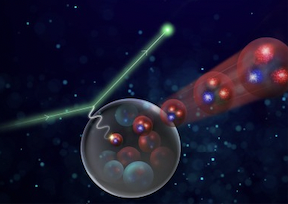’ll begin by briefly reviewing existing experiments and related theory. The bulk of the talk will be on a new approach, discussed in https://arxiv.org/abs/2104.11168, to the time dependence of putative point-like configurations moving within the nucleus. Those considerations indicate that the Feynman mechanism is responsible for the proton elastic form factor, and that the future of color...
Observation of color transparency in baryons would provide a new means to study the nuclear strong force and would be the first clear observation of hadrons fluctuating to a small size in the nucleus. This talk will present the recently published Hall C results ruling out observation of the onset of color transparency in baryons up to Q2=14.3 GeV^2. Additionally, an overview of an upcoming...
The color transparency of a hadron, propagating without absorption in a nucleus, is a fundamental property of QCD, reflecting the hadron's internal structure and the effective size of its color distribution when it is produced at high transverse momentum $Q$. By using the framework of holographic light-front QCD, one can predict the $Q^2$ behavior of the effective transverse size of the...
Generalized color transparency (CT) is related to QCD factorization theorems
allowing one to express cross sections of hard processes with nuclei
in terms of nuclear parton distributions. In my talk, I will review
recent studies of generalized CT in coherent photoproduction of
J/psi mesons in ultraperipheral collisions (UPCs) of heavy ions at the LHC
focusing on the leading twist nuclear...
I give an overview of work done in the relativistic multiple scattering
Glauber approximation (RMSGA) model. I focus on reactions relevant to
color transparency studies at intermediate energies, such as proton,
pion and rho knockout reactions and discuss the agreement with the world
data.

